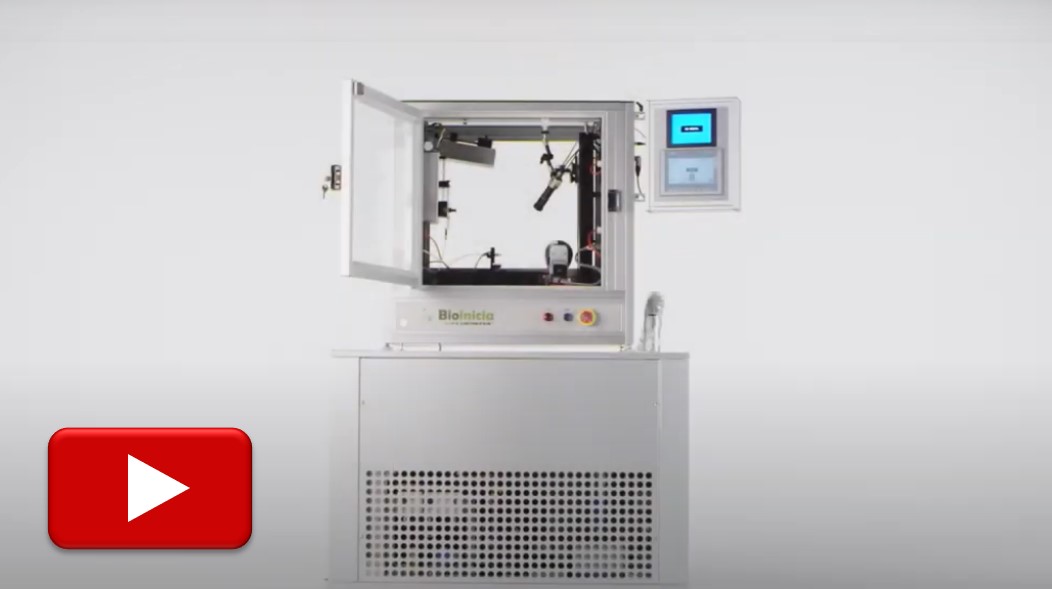The extracellular matrix (ECM) of skin is mostly made out of collagen fibers with other proteins and polysaccharides in smaller quantities. As the skin is primarily two-dimensional, electrospun membrane can be tailored to mimick the skin down to its nanofibers structure. This may potentially improve wound healing both in terms of speed and functional outcome. Engineered skin may also be used to replace in vivo tests if it is found to exhibit characteristics of a normal functioning skin. Although electrospinning is able to form a nanofibrous mesh, there are still several challenges to overcome to create a scaffold that allows good cell infiltration and organization. For a start, conventional electrospinning mesh typically have pore size that are too small for cell infiltration which needs to be addressed.
A known method of increasing pore size of electrospun membrane is to increase its fiber diameter to several microns. However, this would negate the benefit of constructing fibers in the nanometer scale using electrospinning. A layered structure with micro-diameter fiber at the base and nanofiber at the top may combine the beneficial characteristic of both dimensions. Chen et al (2014) used higher solution concentration to electrospin poly(DL-lactide) base layer with fiber diameter of about 2.5 µm. The upper layer comprises of aligned chitosan fibers with diameter of about 243 nm. Full thickness rat wound model showed good restoration of the epidermis and dermis layer with obvious separation using the layered composite with regeneration of keratinocytes and fibroblasts respectively. Cell infiltration up to 32 µm depth was observed which facilitates skin tissue remodeling. This contrasts with the lack of distinct separation of the skin layers where sterilize gauze, PDLLA films and chitosan fibers were used [Chen et al 2014]. Further investigation is required to determine the significance of better cell infiltration into scaffold for wound healing especially for larger wound area in larger animals.
A hydrogel/electrospun membrane combination may also be used to mimic native tissue environment. The skin is made out of a thin epidermis layer and a thicker dermis layer. Pan et al (2014) attempts to reconstruct the structure using electrospun Poly(ε-caprolactone-co-lactide)/Poloxamer(PLCL/Poloxamer) as the upper layer and a hydrogel composed of 10% dextran and 20% gelatin as the lower layer. The upper electrospun layer is designed to provide mechanical support while the lower, more porous hydrogel layer is designed to facilitate cell infiltration and proliferation. Mechanical tests on the nanofiber layer showed tensile strength and modulus well within the range of human skin. Instead of using two separate materials, Uzunalan et al (2013) used collagen for both the upper electrospun layer and the lower freeze dried macroporous sublayer. To improve the adhesion between the two layers, crosslinking was carried out using glutaraldehyde vapor. Kinikoglu et al (2011) went a step further and incorporated bilayer of upper electrospun collagen fibers and lower collagen foams with Elastin-like recombinamers (ELRs). Electrospun collagen with ELRs was fabricated by blending ELRs into the electrospun solution prior to electrospinning while ELRs were added to the surface of collagen foams by surface adsorption. Fibroblasts seeded onto the bilayered construct were able to migrate through the full thickness of the scaffold. After 21 days, epithelial cells were seeded and the construct was cultured in epithelial cell medium with ascorbic acid supplement under submerged conditions for 7 days before elevated at the air-liquid interface for another 14 days with a change in the medium constitution. The epithelial cells at the top of the construct were found to be stratified and thick while fibroblast populated the scaffold. Thinner epithelial layer and poor fibroblast infiltration was found on the collagen bilayered construct.
The distribution of cells in the skin is such that the inner layer comprises mainly of fibroblast while the upper layer closer to the skin surface is mainly populated by keratinocytes. With this organization in mind, Yang et al (2009) cultured fibroblast and keratinocytes on separate electrospun PCL/collagen membranes. These membranes were constructed by alternating electrospinning of fibers directly into a cell culture media and seeding of cells. The layers were built up such that the fibroblast layers were at the bottom and the keratinocyte layers above. After culturing for 3 days, the individual layers were found to be tightly bounded together. This method allows for rapid formation of the 3D scaffold with cell distributions that mimicks native skin.
Published date: 26 January 2016
Last updated: -
▼ Reference
-
Chen S H, Chang Y, Lee K R, Lai J Y. A three-dimensional dual-layer nano/microfibrous structure of electrospun chitosan/poly(D,L-lactide) membrane for the improvement of cytocompatibility. Journal of Membrane Science 2014; 450: 224.
-
Kinikoglu B, Rodriguez-Cabello J C, Damour O, Hasirci V. A smart bilayer scaffold of elastin-like recombinamer and collagen for soft tissue engineering. J Mater. Sci. Mater Med 2011; 22: 1541.
-
Pan J F, Liu N H, Sun H, Xu F. Preparation and Characterization of Electrospun PLCL/Poloxamer Nanofibers and Dextran/Gelatin Hydrogels for Skin Tissue Engineering. PLoS ONE 2014; 9(11): e112885.
Open Access
-
Uzunalan G, Ozturk M T, Dincer S, Tuzlakoglu K. A Newly Designed Collagen-Based Bilayered Scaffold for Skin Tissue Regeneration. Journal of Composites and Biodegradable Polymers 2013; 1: 8.
-
Yang X, Shah J D and Wang H (2009) Nanofiber Enabled Layer-by-Layer Approach Toward Three-Dimensional Tissue Formation. Tissue Engin. A 15 945-956.
▲ Close list
 ElectrospinTech
ElectrospinTech

